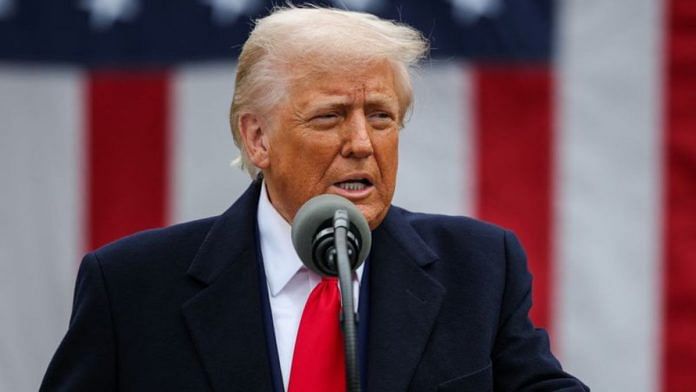The tariff dispute set off by Donald Trump is pushing the United States and China to the brink of a full-fledged trade war. Like the infamous World Wars, the trade war, too, will not be limited to these two major economies. In a globalised world, a value chain mechanism facilitates the assembly of finished products with components made in several countries. If Washington and Beijing decide to boycott one another’s products, this value chain system will suffer, forcing small and medium industries in smaller economies to either look for alternate markets or close down. Everyone would feel the ripple effects – employment could be affected, and global financial services, stock markets, and banking systems could witness a setback or slowdown or both.
Trump 2.0’s tariff impositions and counter measures are neither sudden nor unexpected. Trump 1.0 gave enough indications of the US president’s aversion to globalisation, his contempt for China’s geopolitical and geoeconomic manipulations, his obsession for levying unreasonable tariffs, and his penchant for riding roughshod over globally respected diplomatic norms and finesse.
In March 2018, Trump bid farewell to his economic adviser Gary Cohn. Cohn resigned from his post as the president was set on imposing tariffs on steel and aluminium. The Goldman Sachs veteran was among the most prominent opponents of the tariffs in the White House. The new US government is a much-enlarged version of Trump’s previous ways of domineering administration and a more virulent tariff war, to say the least.
After the first round of tariff imposition, a 90-day ‘pause’ was announced as “people were getting a little bit yippy, a little bit afraid”. The temporary reprieve, if one may consider it so, should give some time to emerging economies to rethink and recalibrate trade policies and reset tariff structures. High tariffs on imports will no doubt increase the price of consignments in the destination country and dent public spending. The American economy has so far benefited from free trade and non-barrier trade. Tariffs, like unilateral sanctions, have been found to be counter-productive economically, politically, and even strategically. US sanctions on India after the nuclear test in 1998 did more damage to American interests than they did to the Indian economy.
Realise the gravity
India has so far reacted to US tariffs with extreme caution and sensible prudence. While all the micro details of the tariff structure on India are yet to be made public, it will take sufficient time for the commerce and other relevant ministries to take stock of the situation and determine the impact on exports. But the government needs to realise the seriousness of the tariff challenge and prepare the industry to benefit from the opportunity that the global economic situation offers.
Indian manufacturing took a backseat after earlier governments allowed cheap Chinese goods to flood the Indian market. Core industries such as steel, cement, coal, and energy have not upgraded their manufacturing process in about four or five decades. Industrial automation can improve quality and scale of production but the government appears to be oblivious to facilitating automation through tax cuts and incentives.
While corruption at the top rungs of governance is a thing of the past, ease of business at the Micro, Small and Medium Enterprises (MSME)-level is yet a chimera. Indian manufacturing today is at the same stage where Chinese manufacturing was, about 40 years ago. If we don’t want to miss Industry 4.0, the government must urgently encourage the adoption of automation, robotics assisted manufacturing, tax exemptions for Internet of Things (IoT) devices, and boost the use of artificial intelligence to improve the productivity and quality of manufacturing processes.
Unlike manufacturing in China, which is primarily dependent on State Owned Enterprises (SOEs), India’s private sector is robust and independent. Chinese SOEs accounted for over 60 per cent of the country’s market capitalisation in 2019, and generated about 23-28 per cent of the country’s GDP in 2017. Ninety-one SOEs were among Fortune 500 global companies in 2020.
Also read:
Will China sail through?
Needless to say, the Chinese Communist Party and the state apparatus has to take the major brunt of the 125 per cent tariffs imposed on them and react accordingly. In this major geopolitical and geoeconomic contest with the US, China has decided to hit back with higher tariffs. President Xi Jinping’s old speech has also resurfaced amid the tension, where he reportedly compared his country to an ocean that is accustomed to weathering storms.
The Chinese zodiac, known as Sheng Xiao, follows a 12-year cycle with each year represented by an animal. The characteristics of each animal supposedly influence the year they represent. The Communists frown upon ancient traditions as superstitions. But it is widely believed in China that those born in the Year of the Snake – while destined to witness uncertainty, turbulence, and chaos in relationships – are cunning, mysterious and adaptable to unpredictable situations.
This is all the more evident if that person happens to hold the highest public office. Xi Jinping, born in 1953, the Year of the Snake, cannot overrule the traditions. And, to add to his troubles, 2025 is the Year of the Snake as well. China will have to wait until Donald Trump withdraws tariffs, or until 2026, the Year of the Horse, for its economy to gallop.
Seshadri Chari is the former editor of ‘Organiser’. He tweets @seshadrichari. Views are personal.
(Edited by Zoya Bhatti)







Poor, socialist India will not gear up. She is busy with socialism, diet, corruption, language, etc.